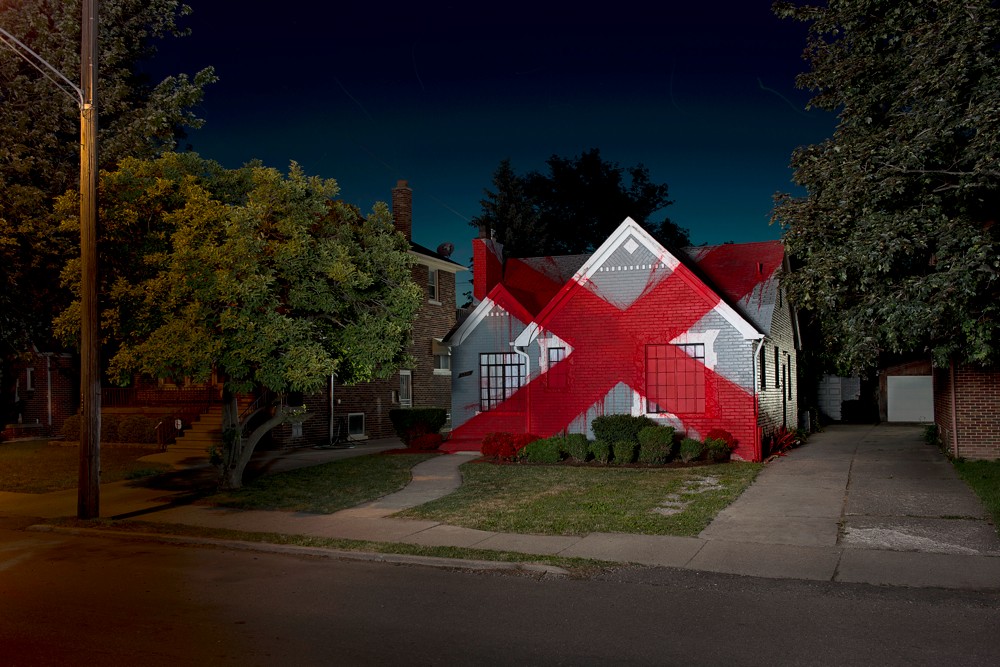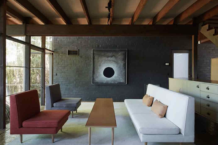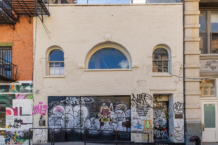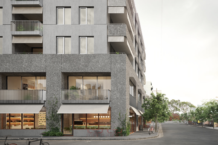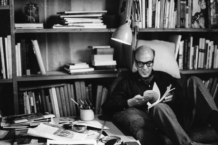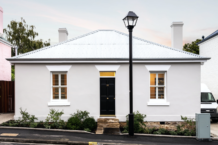Impermanent Structure: Ian Strange on Suburban
Arts & Events, People - by Charlotte Cornish
For the past two years New York-based Australian artist Ian Strange has worked with a film crew and team of volunteers in Ohio, Detroit, Alabama, New Jersey, New York and New Hampshire to create seven site-specific interventions with suburban homes. Film and photographic documentation of these interventions form the basis of his current exhibition at the National Gallery of Victoria Ian Strange: Suburban.
Through Suburban, Strange dissects the icon of the home. A quiet rebellion is visually articulated, where Strange eloquently questions the stability of built form by intervening with its physical permanence, creating ominous, temporal architecture that bestows a sense of isolation.
Along with assisting him in the installation of the exhibition, Charlotte Cornish sat down with Ian after the exhibition’s opening to talk about his work, influences, creating dramatic imagery without digital implementation and the sensitivities around burning and raising homes in deep suburban America.
 Ian Strange, Corrinne Terrace, 2011
Ian Strange, Corrinne Terrace, 2011
How do you describe the concept of Suburban?
Ian Strange: Suburban is a multifaceted exhibition of film, photography and installation based around seven site-specific works created with suburban houses along the east coast states of America.
The idea of suburbia is pertinent to popular culture; and the word itself has colloquial connotations. I’m curious about your personal relationship with suburban culture, what does suburban mean to you? Is this project self-reflexive?
The name of the project sort of developed as I was making it. I like the double meaning of it, which broadens out to larger ideas of the ordinary, the familiar and the mundane. It captures the notions of a fear and resentment I have from growing up in the suburbs, wanting to escape when I thought I was going to be trapped. The element that is self-reflexive is something that I explored in my Home project, which expanded that personal investigation. But, as this project (Suburban) developed, it became a broader investigation that fleshes out the symbol of the home and how we relate emotionally to the icon of the home.
In Home you re-constructed your childhood home and presented it out of context, making the private public. Were ideas of public and private space something that carried over to Suburban?
I think in the sense that the home is your first idea of safety and security; there is a sense of you understanding inside/outside and private space/public space through your understanding of the home. For me, the home is a place of security and to see it as a vulnerable object, to see it destroyed, disappeared or subverted, to play with the reality which is the impermanence of that object, I think is then playing with that overall idea of stability and security that is emotionally resonant in a home.
 Ian Strange, Home installation view, 2011.
Ian Strange, Home installation view, 2011.
You are based in the United States but originally from Perth. Was there something particularly compelling about suburbia in an American context vs. an Australian one to your project?
There are two things. First, a lot of Australians grow up with a strange familiarity to the American suburban home through popular culture, so many of the homes in my project feel distantly known. I think that the westernised idealism of suburbia has trickled down from popular culture. That 50s, 60s, 70s idea of architecture is really related to an idealised suburbia. Secondly, having moved to the States, looking back on it now, there is a part of me trying to make sense of the place and searching for a home outside of Australia. Not feeling at home in Australia and not feeling at home in the States is something that definitely led me to make the Home installation work, and broadly I think creating the Suburban project in the States could be an attempt to orient myself between these two poles.
I am aware you had to convince communities and authorities to agree to these interferences and in most cases return the houses back to their original form once documentation was completed. Can you talk through this process?
Actually most of the houses were destroyed afterwards and only two of them were restored. But overall it’s an intensive process and I worked with a huge team of people. I had a core crew of about five people. Primarily, I work with my partner, Jedda Andrews, and she took the lead on project managing most of Suburban with a mixed team of producers, photographers and filmmakers. Additionally, in each city we had a local crew as well, so there was a large level of community engagement. We would make sure, before we were on a street or started working on a house, that we had the support of the community. It is such an expensive exercise that if we went in there and somehow the project was shut down from aggressive complaints from neighbours, we would have spent all this money and ended up not achieving what we set out to do, which is something we couldn’t afford. So a lot of the time there were houses we just didn’t do because we felt there were too many risks.
 Ian Strange, Suburban Project film still (Image: Jessie English)
Ian Strange, Suburban Project film still (Image: Jessie English)
How did you discover the houses? Were there specific architectural or aesthetic considerations in your selections or was it a matter of what was made available to you?
A lot of houses we decided against because they had strange architectural features, or they were too modern. I was looking for a house that reflected the icon of a house once it is reduced. A lot of the concept sketches were made onto what is essentially a child’s drawing of a house and it became a question of ‘how does this image react against this icon?’ Each house was picked for its mundane appearance, encapsulating my idea of what is suburban – very non-descript. I think by them being mundane it allows people to react to the idea of the house as opposed to it being tied to a specific time or place. I wanted to explore the idea of the house, of the home, of suburbia.
The specific locations of each piece are not initially obvious. How important is context?
It’s really important that you don’t know the locations. I had the city names removed from the didactics because I wanted it to be a survey of American homes that were not necessarily specific to each region. It’s important that the works are not read it in that way, that you react to the homes without context. I think when you say, “this house is from Detroit”, it adds a political context to it, which is not specifically important to the reading of this work. It was really important that we picked different styles of architecture, different backgrounds, different landscapes with different trees, so it became a survey and you couldn’t actually place all the work in one region or at one time.
We shot at different times of day, some were shot at night, there’s one shot in the snow, and so the works are not specific to a time or place. The lighting is supplemental, controlled and surreal so that there is no actual time signature. We film them at different time sequences – some were shot at really high frame rates, some were shot at standard frame rates and some of them were shot with time lapse – but they all sit within a surreal atmosphere, out of time and out of context. It is about removing the house from its location and specific context.
Many socio-political and economic factors have contributed to a housing crisis in suburban America and dissatisfaction with middleclass structure. Did these notions inform your project?
They informed my ability to make the project in the sense that these factors allowed me to make the project. I understand that it is a really potent reading of this work, but it’s not one that I want to focus on aggressively. I wasn’t aiming to create a political work, even though I am completely aware that the house and home is political. I think that limits the work. My intention with Suburban is an emotional reaction to the home, exploring the psychology of the home and its personal readings as a symbol of stability and structure. There is a larger metaphor at play, something more poetic, about how you understand your world rather than a political statement. I understand that reading and I am aware that it’s there but I wouldn’t want to limit it by saying that it’s the only reading of this work. It was not my intention to make a poignant work about the global financial crisis.
Although Suburban is grand in scale the result is formally minimal, creating an ominous, haunting atmosphere and sense of isolation that resonates throughout each piece. Is this ghost-like atmosphere a comment on suburbia or a means to focus primarily on the icon of the home?
I’ve always felt a sense of threat and isolation from the icon of the home, which links back to my own idea of suburbia. I think in a way it’s me being honest about my experience in the suburbs and what I have taken from those experiences. I do feel there is a quiet rage, a quiet anger and a quiet violence in suburbia. There is a sense of the unspoken that is part of the work’s DNA.
It’s an interesting question because there are distinct aesthetic decisions you have to make in the production of the work – but I think they come from knowing what I want the outcome to feel like. There’s an aspect of theatre to making this work. You’re trying to evoke an emotional reaction in people and because there’s no language or narrative to it, specific effects are used to convey certain emotions. I wanted it to be quiet and distant. So the aesthetic ideas, tone and overall mood in the work comes back to this core idea and feeling I have.
Gregory Crewdson’s Beneath the Roses series (2005) and Harmony Korine’s Gummo (1997) are two projects that come to mind when considering contemporary interpretations of suburban America, however both Crewdson and Korine include people within their respective narratives. Can you explain why people are noticeably absent within your project, even though there is the presence of a person having been there?
 Gregory Crewdson, Untitled, 2004 (Image: Gagosian Gallery)
Gregory Crewdson, Untitled, 2004 (Image: Gagosian Gallery)
We worked really hard to not include people. There is meant to be no human presence in the work. I wanted people to react to that isolation, to the static piece of architecture devoid of life. If you put a person in there, people are going to relate to them and it creates a narrative and I don’t want narrative; I want to react to the icon and reduce it. I have no interest in creating narrative. I love that you mentioned Gummo. Harmony Korine shot that in Ohio as well. It was after a hurricane that he shot the scene with Tummler and Solomon riding their dirt bikes down that barren road. Korine is the first artist that influenced me actually. I saw him on Letterman when he was around 19 years old and this guy was like me, doing anything he wanted to do.
Elements of your practice are similar to contemporary Australian artist Rosemary Laing’s work. Laing’s photography is not digitally manipulated; rather her images document specific interventions with nature and are produced with a large team. How important is it to employ similar production processes that enable your images to be created without digital manipulation?
 Rosemary Laing, Prowse, 2010. (Image: Tolarno Gallery, Melbourne)
Rosemary Laing, Prowse, 2010. (Image: Tolarno Gallery, Melbourne)
Really important. I met Rosemary in New York at my last show and it blew my mind that I never knew that she worked with Gordon Matta Clark on Food in the 1980s in New York. Matta Clark is a huge reference and influence for me. Rosemary has been an influence also; her recent series Leak is really fantastic. I’ve admired her work for a long time, so to know that Rosemary and Matta worked together was a moment when artistically things started coming together in my mind.
So how important is it for you to go to these lengths, like Laing, where you have teams behind you to control the image without manipulation?
At the heart of the work is documentation of an intervention. It’s important that the reality of that intervention is maintained no matter how much production value you add to it. There is a very delicate line. For example, the skull house, we shot at dawn and then during the day we set it on fire. Ideally, I wanted the dawn light on fire but it was logistically impossible to set the house on fire at dawn – legally with the EPA and licensing you can only burn during the day. – so I had the plates to be able to take the dawn light and have the fire during the day, but when you look at that image you’re going to be able to tell. And even if you can’t tell, I know what happened. I still think the image is really effective. We shot it again at dusk and I think it works brilliantly. There is a reality captured, that the burning of the house and the painting of it is all there in one photograph, in that frame, as it happened.
“One of the most important things for me is that we went there and actually did it… its really important to me that people understand that the works aren’t digital.”
I think the moment people point at something and say it was digitally altered is the moment you remove the sincerity of the act. One of the most important things for me is that we went there and actually did it. I mean the circles are imperfect, there is patchiness on the red house, you can see the stroke marks – its really important to me that people understand that the works aren’t digital. It becomes a problem when images go online and become compressed, you can’t see these intricate details as much as you can in the gallery. I think the act is really important.
Your work crosses over many art and design forms – photography, moving image, sound, painting, sculpture, and architecture. Were you formally trained in any of these fields?
I am trained in film but it took me a really long time to realise my potential as a filmmaker. Actually, a friend introduced me to the Andrei Tarkovsky book Sculpting in Time and that was a moment when I realised that narrative isn’t important, and as an artist I can work with film.
Do you identify your approach to art making as collaborative?
Yes. The making is completely collaborative. I would equate it to film, like a production. I also have a painting practice, which is something I have left behind recently, but for me going into the studio when you’re the only one responsible for the work is different. You go in there and you work on it and finish it, which is a wonderful way of working. But there are also interactions, challenges and the group adventure of doing these projects collaboratively and seeing what you can accomplish with other people, which excites me.
Like Home, formal photography, moving image and installation form the basis of Suburban. This is a notable departure from your street art and painting-centric earlier practice. Do you consider this an organic evolution or has this shift been intentional?
It’s been intentionally organic [laughs]. There are limitations with my painting practice and what you can do in the ‘street art’ genre. Home was the first time I took all of my other interests and put them into my work. Elements such as film, collaboration and performance, which I am interested in but couldn’t explore in the same way with painting. I found painting quite limiting.
From the beginning of your practice architecture has been a consistent element, whether interfering with the urban landscape or exploring suburbia and the icon of the home. What drives you to consistently explore the architectural elements of human life?
That’s a good question. I may have to talk around it… I don’t know if it’s really an attraction to architecture as such. I’m attracted to the home because it’s something of an icon – it’s sacred. There is a real impermanence to the home that is not explicit to the common understanding of it. Most people think of home as a really permanent structure. I don’t know if there is necessarily a link in my work that is about architecture but perhaps it’s more about permanence and attacking things that seem to be permanent, these structures. I think that’s why I am interested in things that appear to be vandalised or destroyed; I am subverting, twisting and playing with those icons and ideas. There is an earlier work of mine that has the Kid Zoom tagline on a kangaroo and I equate that to Home more closely than I would to any of my earlier graffiti work.
Why is that?
The kangaroo work was really about identity, self, Australia and the house, and Home was like that as well. It destructed the idea of the Australian suburbs, my idea of the Australian suburbs. Those two works are quite aggressive and explicit. I think I am quieting down and refining this idea, but there is still that core questioning and attacking of these permanent structures. I’m still being a shit really. [Laughs]
I think it’s interesting your mentioning attacking permanent structure, as one of the consistent elements for me in your early and current work is architecture – and in a very literal sense architecture is a permanent structure within society.
The consistent thing for me is the sense of isolation and my own reaction against these permanent structures. A 16 year old doing graffiti is not consciously making a statement about anything in particular. At 16, I was completely out of control and graffiti I guess was part of this larger self-destruction. But I think I can reflect on that and see all the elements – I was a creative kid in Perth who was completely lonely and angry about having to be an adult, who had very adult thoughts but was patronised a lot of the time. There was a feeling as if I was going to be in Perth my whole life and there was no way of getting out. You end up in this negative cycle and you go out and make graffiti as an outlet. You can later look back on that and intellectualise your reasoning, but really that’s the psychology that is ingrained; they are your formative years…
So now I can go back and make a comment with reflective work about that time. But essentially I’m still questioning – what are these permanent structures? It’s a luxury to be able to attack this permanence but maybe they are questions that should be asked and maybe they are things we should react against. People create stability and security for a reason; and we make homes in our minds more than what they physically are. So, maybe it’s an interest in architecture because of the ideas that are placed on architecture, these ideas of permanence, how these things are lasting. Permanence, stability and control are all elements of architecture and they essentially state that “this are where I live, this is my building, and this is where I stand”. But these structures aren’t necessarily permanent. Just travel through Detroit and you will see.
 (Ian Strange on location in Ohio, March 2013. Pic: Christopher Hersey)
(Ian Strange on location in Ohio, March 2013. Pic: Christopher Hersey)
Ian Strange: Suburban
Until September 15
NGV Studio, Ian Potter Centre, NGV Australia
Federation Square
www.ngv.vic.gov.au
By Charlotte Cornish
